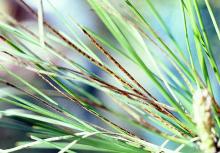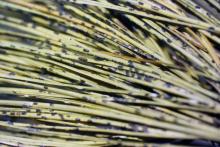Cause Lophodermella spp. Four species cause forest problems on lodgepole, ponderosa, and white pine. Lophodermella concolor and L. morbida occasionally are found on ornamentals. L. arcuata on white, whitebark, and limber pine; and L. concolor on lodgepole pine, L. montivaga on lodgepole pine and L. morbida on ponderosa pine. L. morbida is particularly severe on off-site ponderosa pine in the Willamette Valley of Oregon and in southern Oregon. Fruiting bodies are on last year's dead, fallen, or attached needles, dispersing spores that invade the most recently produced foliage.
Symptoms Death of last year's needles with the development of football-shape or elongate fruiting bodies (hysterothecia) on dead needles. Hysterothecia may be black, gray, or the same color as dead needles, depending on the fungal species. Trees have a lion-tail appearance and have weak, retarded growth.
Can easily be confused with other needle cast diseases. Needle cast diseases are identified by microscopically examining fruiting bodies and spores. Needle casts can also be confused with annual (normal) fall needle drop. Most conifers shed some of their oldest needles in the fall. These old needles often turn yellow or brown before falling off.
Cultural control
- Avoid using seed from susceptible (off-site) tree sources.
- For high-value trees, remove and destroy fallen needles that collect in branch crotches and on the ground.
- Avoid planting in low-lying areas with poor air drainage.
- Space plants for good air circulation.
- Forest trees-thinning stands is helpful.
- Control weeds and vegetation around the bases of trees.
- Shear Christmas trees during dry weather.
Chemical control Spray when needles are half grown and again when growth ceases.
- Armada 50 WDG at 9 oz/100 gal water. Do not use a silicone-based surfactant. Not for nursery or greenhouse use. Group 3 + 11 fungicide. 12-hr reentry.
- Bravo Weather Stik at 2.75 to 5.5 pints/A or Daconil Weather Stik. Group M5 fungicides. 12-hr reentry.
- CuPRO 5000 at 3 to 5 lb/A. Group M1 fungicide. 48-hr reentry.
- Daconil Weather Stik at 2.75 to 5.5 pints/A. Do not use a spreader-sticker. Group M5 fungicide. 12-hr reentry.
- Dithane M45 at 2 to 4 lb/A or per 100 gal water plus a spreader-sticker. Registered for use on Christmas trees. Group M3 fungicide. 24-hr reentry.
- Echo 720 at 2.75 to 5.5 pints/A. Group M5 fungicide. 12-hr reentry.
- Heritage at 3.2 to 8 oz/A plus a non-silicone-based wetter sticker. Registered for conifers including Christmas trees. Group 11 fungicide. 4-hr reentry.
- Mural at 3.5 oz/100 gal water. Registered for ornamentals grown in nursery, greenhouse and landscapes. Group 7 + 11 fungicide. 12-hr reentry.
- Penncozeb 75 DF at 2 to 4 lb/A. Registered for use on Christmas trees. Group M3 fungicide. 24-hr reentry.
- Quadris at 6 to 15.5 fl oz/A for Christmas tree use. Do not apply more than twice sequentially. Group 11 fungicide. 4-hr reentry.
- Spectro 90 WDG at 1 to 2 lb/100 gal water. Registered for conifers grown in nursery, greenhouse or landscape. Group 1 + M5 fungicide. 12-hr reentry.
Reference Hansen, E. and Lewis, K.L. 1997. Compendium of Conifer Diseases. St. Paul, MN: APS Press.



